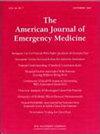Waveform conversion as a prognostic factor of poor prognosis in patients undergoing extracorporeal cardiopulmonary resuscitation
IF 2.7
3区 医学
Q1 EMERGENCY MEDICINE
引用次数: 0
Abstract
Background
Extracorporeal cardiopulmonary resuscitation (ECPR) is a resource-intensive treatment for refractory out-of-hospital cardiac arrest (OHCA), underscoring the importance of identifying patients with favorable neurological outcomes. We investigated whether waveform changes from initial shockable cardiac rhythm to alternative cardiac rhythm upon hospital arrival can predict the outcomes of patients undergoing ECPR for OHCA.
Methods
This secondary analysis of the SAVE-J II study included patients with OHCA who received ECPR at 36 emergency departments in Japan. We identified patients who experienced OHCA with shockable cardiac rhythm at the scene and subsequently underwent ECPR. We performed multivariable logistic regression analysis to assess the association between the waveform at hospital arrival and outcomes. The primary outcome was a favorable neurological outcome (cerebral performance category 1 or 2) at 1 month after arrest.
Results
Overall, 1114 patients were eligible for analysis. The rate of achieving a favorable neurological outcome was highest in patients who had sustained shockable cardiac rhythm on hospital arrival, followed by those with pulseless electrical activity and asystole (22.4 % vs. 9.5 % vs. 2.7 %, P < 0.001). The difference remained significant after adjusting for confounding factors, with adjusted odds ratio (95 % CI) of 0.35 (0.21–0.58) and 0.08 (0.03–0.20) for pulseless electrical activity and asystole groups, respectively.
Conclusions
The waveform transition from shockable to alternate cardiac rhythm was associated with significantly poor outcomes after ECPR for OHCA. Patients with waveform conversion from VF/VT to asystole upon hospital arrival had exceedingly low probabilities of achieving favorable neurological outcomes, necessitating careful consideration of ECPR's appropriateness in this population.
波形转换作为体外心肺复苏患者预后不良的预后因素
体外心肺复苏(ECPR)是一种资源密集型治疗难治性院外心脏骤停(OHCA)的方法,强调了识别神经系统预后良好的患者的重要性。我们研究了到达医院后从最初的震荡心律到替代心律的波形变化是否可以预测OHCA患者接受ECPR的结果。方法对SAVE-J II研究的二级分析纳入了日本36个急诊科接受ECPR的OHCA患者。我们确定了在现场经历OHCA并伴有心律震荡的患者,并随后进行了ECPR。我们进行了多变量logistic回归分析,以评估到达医院时的波形与结果之间的关系。主要转归是停搏后1个月良好的神经学转归(脑功能1或2类)。结果共有1114例患者符合分析条件。达到良好神经预后的比率最高的是入院时持续心律震荡的患者,其次是无脉性电活动和心脏骤停的患者(22.4% vs 9.5% vs 2.7%, P <;0.001)。校正混杂因素后差异仍然显著,无脉电活动组和无搏动组校正比值比(95% CI)分别为0.35(0.21-0.58)和0.08(0.03-0.20)。结论从震荡到交替心律的波形转换与OHCA患者ECPR后的不良预后显著相关。到达医院时波形从VF/VT转换为心脏骤停的患者获得良好神经预后的可能性极低,因此需要仔细考虑ECPR在该人群中的适用性。
本文章由计算机程序翻译,如有差异,请以英文原文为准。
求助全文
约1分钟内获得全文
求助全文
来源期刊
CiteScore
6.00
自引率
5.60%
发文量
730
审稿时长
42 days
期刊介绍:
A distinctive blend of practicality and scholarliness makes the American Journal of Emergency Medicine a key source for information on emergency medical care. Covering all activities concerned with emergency medicine, it is the journal to turn to for information to help increase the ability to understand, recognize and treat emergency conditions. Issues contain clinical articles, case reports, review articles, editorials, international notes, book reviews and more.

 求助内容:
求助内容: 应助结果提醒方式:
应助结果提醒方式:


